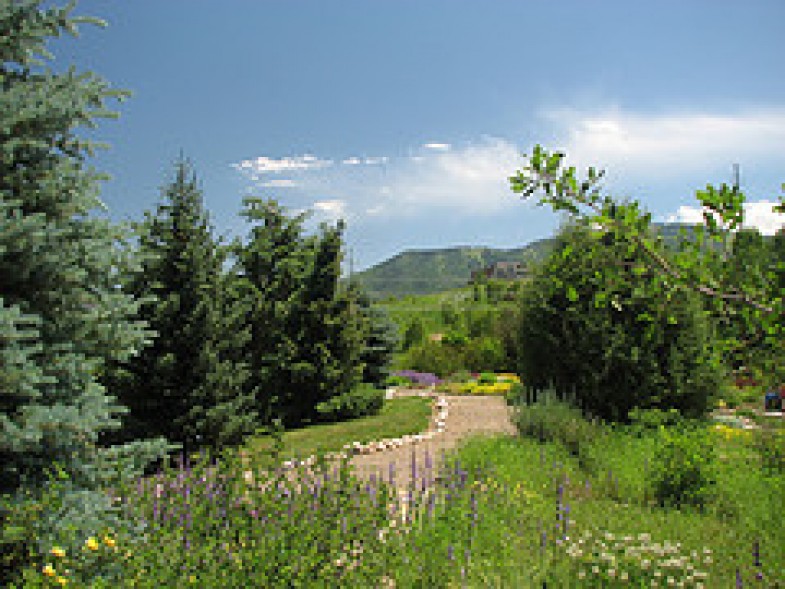“Life actually forms and changes its own environment.” That bit of wisdom, from evolutionary biologist and UMass professor Lynn Margulis, is inscribed on a ceramic tile glued to the side of a brick building in my hometown, Amherst, Mass. Every time I pass that tile en route to Antonio’s Pizza or Collective Copies, I have a small burst of civic pride that someone, somewhere, in the town had the imagination and persistence to makes that unusual bit of public art happen.
Across the street, on the side of the Amherst Chinese restaurant, is another tile, this one with a quote from the distinguished American historian Henry Steele Commager (and longtime town resident): “First rate men and women will not and cannot work under conditions fixed by those who are afraid of ideas.” The word “ideas” is centered in a starburst design.
Since spending last week in Colorado, where I stayed in several Rocky Mountain towns, I have been become more sensitized to the ways in which communities express their identities and values in their public spaces. My experience at the Yampa River Botanic Park in Steamboat Springs is an example. I’ve been to my share of botanical gardens, including fantastic ones in Washington, D.C., and Paris, France. But there was something special about this several-acre garden. It was run by a volunteer nonprofit, the Yampa River Botanic Park Association, in cooperation with the City of Steamboat Springs, which was acknowledged as “a loyal resource-partner.” The City had donated the land, but the Association maintains the Park as a kind of self-organized commons.
[inline:1]
This fact is evident immediately. Each of the several dozen gardens — for rose bushes, western wildflowers, lilies, edible plants, flowers that attract butterflies, medicinal herbs used by Native Americans, and many others — is well-tended and artfully designed. (This photo was taken by my son, Thomas.) But the park is not a professionally managed enterprise; it’s clearly a garden of, by and for the people. Sculptures by local artists abound. Some gardens are dedicated to now-deceased gardeners. The local Buddhist center maintains a meditation garden. Other groups are stewards of specific gardens. Admission is free, but donations are encouraged. The place brims with pride and local character. To have such personal energy and imagination devoted to a proud public display of flowers and plants — hardly seen as a “necessity” in these straitened civic times — is…well, touching.
A few days later, my family passed through the Stapleton neighborhood of Denver — the site of the city’s former airport (which has since been replaced by a new one on the outskirts of town). The neighborhood is an attractive example of New Urbanism redevelopment. It mixes street-level retail with condos and apartments, all of it in a pedestrian-friendly way and with thoughtful amenities like a park with public art that entices people to linger and mingle.
In spite of all of its enlightened design, however, the neighborhood had a singular failing: it had no visible history. Everything had been built in the past seven or eight years, and the idiosyncratic character of the people who lived and worked there had no expression on the street. No family restaurants, no unusual homegrown businesses, no idiosyncratic anything. The streetscape was so clean, well-ordered and tasteful that it felt as if no one really lived there. It didn’t help that most of the shops were faux-local restaurant chains that looked as if marketing consultants had pored over every last inch of their menus and interior design.
Finally, as I reflected on how the community heart-mind is expressed, or not expressed, on the streets, I thought of the weighty challenge now facing Los Angeles residents. A few weeks ago, it was announced that the noted architect Frank O. Gehry is going to design a 40- to 50-story skyscraper in L.A., next to Disney Hall, as part of a $1.8 billion Grand Avenue redevelopment project. The question at hand is, What will the City do with the 16-acre space between City Hall and the top of Bunker Hill?
My friend and colleague Martin Kaplan of the Norman Lear Center is calling for what he calls a “ Grand Intervention” — an open solicitation of ideas from the public, architects, New Urbanists, philanthropists, community groups, and many others, to help imagine bold new uses for this space. There are hopes that the park-to-be will be L.A.‘s version of Central Park — a place where cultural performances, political gatherings, farmers markets and pickup sports games might be held.
But will it? asks Kaplan. That’s unclear. If the Professionals Who Know Better control the process and declare from on high what the space shall be, it could be a disappointment. Kaplan declares, “It’s not too late to bust things open for an eruption of creative energy, to ventilate and galvanize and democratize the design process, to invite citizens of Los Angeles, architecture fans, design junkies and imagineers from around the world to brainstorm truly breakthrough ideas for our 21st century civic space.”
In some ways, the design of the park will be both a test and an opportunity for the City of Los Angeles. What ultimately emerges will reveal a great deal about the people, civic governance and culture of that city.


